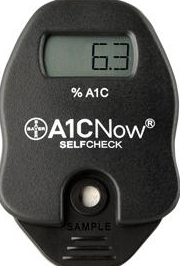A1cNow
Check your A1C at home?
Since COVID-19, we all need to social distance (an unfortunate term- physical distancing is better). True social distancing can lead to isolation, depression etc.
The OTC FDA approved A1cNOW test is available at local pharmacies. Both CVS and Walgreens have branded the product. It’s advertised on the web for between $40 and $60 for 2 tests. It is not covered by insurance. There are several studies indicating good correlation between the A1cNow test and the gold standard (high-performance liquid chromatography) used by labs, e.g. LabCorp and Quest. I have been told by a colleague that the A1cNow test had numerous accuracy/stability problems at its inception, it’s not known if now improved. Reviews found on the web are mixed. Some are quoted here.
- “Worthless. Out of two boxes (4 tests) I have only been able to get one to work properly…”
- “I used this test kit an hour or two before going to my endocrinologist. It showed my A1c to 6.4. The test at my endocrinologist’s office showed 7.5…”
- “Measured a1c level with the CVS home kit 4 times over 2 days (2 times a day). The results were: 5.5; 5.9; 5.9 and 5.8. The average of 4 measurements was 5.78. On day 3 had a lab test done, and it resulted in 5.9. So, the home kit is very accurate and highly recommended.”
- “I’ve been working on blood sugar problem, my A1c was 7.3, 7.0, 6.4 and 6.7, very unstable and frustrating, since I am in my 70’s, doctor considered those numbers not optimal but acceptable. I decided to try home A1c test about a month ago. 5.9 on first try, with disbelief, I tried the second test 6.0. Today, at doctor’s office 6.2…. is it close enough for me, heck yeah !!!”
The bottom line. A test done at a laboratory or in your doctor’s office is likely more accurate. On the other hand, the A1cNow over-the-counter test can be reliable. If going to use the A1cNow, it is a good idea to check blood sugar 3 or 4 times a day for a week or more, take the average and convert it to an A1c as noted on our website. Click here. If the converted A1c (from average blood sugar) and the A1cNow match very well it is likely to be reasonably accurate

Higher A1cs
Average A1C levels increase at the Diabetes Control Center in January and in July. The good food over the Holidays is responsible for the January rise and the seasonal increase primarily comes from fruit being in season. Around here peaches from May until Labor Day and watermelon from June through September.
In a typical case, A1c may move from 6.5% (average blood glucose about 145mg/dl) in October to 7.5% (about 168mg/dl) over the holidays. I that harmful? No studies have shown that a TEMPORARY increase in A1c or average blood sugar is harmful in the long run. However, it is known that temporary increases in blood sugar cause an increase in several blood components that promote clotting and hardening of the arteries.
Many studies show that prolonged A1c of 6.5 -7% reduces risk of complications 80 -90%.
It is better NOT to have increases in blood glucose over the Holidays. However, if it happens and is promptly corrected there is little prospect of harm.
It is important to remember that average blood sugar from your glucose meter may not accurately reflect A1c because there are many times in the day when the sugar is not being checked. Average sugar from continuous glucose monitoring, however, is more likely to reflect A1c. Click here to calculate A1 from average blood sugar Food tips here.
A1c Calculator
A1c is the gold standard of diabetes control. Like everything else, it has limitations. The A1c calculator is likely to be spot-on If one checks blood sugar 7 times daily, e.g. before and after each meal plus bedtime and 2AM. However, we find good correlation between A1c with 90 or even 30-day blood sugar averages of 3 – 4 checks daily.
Control blood sugar, reduce complications!
How do we measure control?
A1c.
Blood sugar at your doctor’s office.
Fingerstick blood glucose determinations.
Continuous glucose monitoring.
Fructosamine.
Glycomark
A1c advantages.
Provides an estimate of average glucose (blood sugar) over the past 6 to 12 weeks.
Can be done from a fingerstick in your health care provider’s office.
A1c disadvantages.
Can be falsely elevated if something causes red blood cells to survive longer than the expected time (e.g. iron deficiency anemia, vitamin B12 and folate deficiency anemias, surgical absence of the spleen, very high triglycerides, chronic use of alcohol, chronic use of opioids, chronic use of aspirin, vitamin C when A1c is measured by some methods.
Can be falsely low if something causes red blood cells to survive shorter than the expected time frame. (e.g. recent blood transfusion, sickle cell trait, chronic blood loss, pregnancy, vitamin C and E) *
*NOTE: several items may produce either falsely elevated or falsity decreased A1c.
